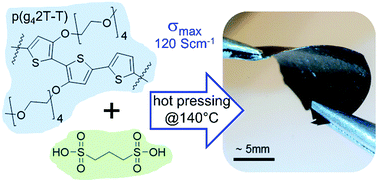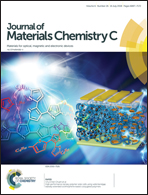Highly stable doping of a polar polythiophene through co-processing with sulfonic acids and bistriflimide†
Abstract
Doping of organic semiconductors is currently an intensely studied field, since it is a powerful tool to optimize the performance of various organic electronic devices, ranging from organic solar cells, to thermoelectric modules, and bio-medical sensors. Despite recent advances, there is still a need for the development of highly conducting polymer:dopant systems with excellent long term stability and a high resistance to elevated temperatures. In this work we study the doping of the polar polythiophene derivative p(g42T-T) by various sulfonic acids and bistriflimide via different processing techniques. We demonstrate that simple co-processing of p(g42T-T) with an acid dopant yields conductivities of up to 120 S cm−1, which remain stable for more than six months under ambient conditions. Notably, a high conductivity is only achieved if the doping is carried out in air, which can be explained with a doping process that involves an acid mediated oxidation of the polymer through O2. P(g42T-T) doped with the non-toxic and inexpensive 1,3-propanedisulfonic acid was found to retain its electrical conductivity for at least 20 hours upon annealing at 120 °C, which allowed the bulk processing of the doped polymer into conducting, free-standing and flexible films and renders the di-acid a promising alternative to commonly used redox dopants.



 Please wait while we load your content...
Please wait while we load your content...